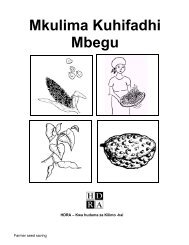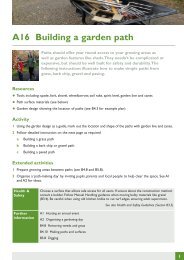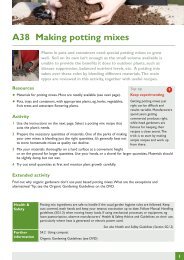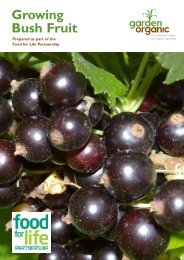Download PDF - Garden Organic
Download PDF - Garden Organic
Download PDF - Garden Organic
You also want an ePaper? Increase the reach of your titles
YUMPU automatically turns print PDFs into web optimized ePapers that Google loves.
http://www.gardenorganic.org.uk/organicweeds<br />
Early, shallow stubble cultivation a few days after cereal harvest has been shown to<br />
reduce weed seed numbers in the soil but has little effect on the emerged annual weed<br />
population in the crop that follows (Pekrun & Claupein, 2006). However, when<br />
followed by deep ploughing in the autumn there is a reduction in perennial weed<br />
populations compared with leaving the stubble untouched. Early stubble cultivation is<br />
not beneficial in reducing volunteer crop seeds.<br />
While stubble cleaning may not be appropriate for dealing with the shed seeds of<br />
some weed species it can be an effective way of controlling certain important weeds<br />
including charlock (Sinapis arvensis), common chickweed (S. media), groundsel<br />
(Senecio vulgaris), wild radish (Raphanus raphanistrum), shepherd’s purse (Capsella<br />
bursa-pastoris) and some speedwells (Veronica spp.). The surface soil should be<br />
cultivated to a depth of not more than 2 inches and this operation repeated at 14 day<br />
intervals. Some farmers take this a stage further and prepare a seedbed at this time<br />
but leave it unsown until spring. The land is cultivated at regular intervals to deal<br />
with seedling weeds and then ploughed after Christmas in preparation for spring<br />
cropping. Weeds controlled by ‘autumn cleaning’ include blackgrass (A.<br />
myosuroides) and charlock (S. arvensis). Nutrient leaching is likely to be a problem<br />
in soil left bare over winter.<br />
Where there is a 2-4 week period in the autumn between the harvesting of one crop<br />
and drilling of the next, there is an opportunity for early tillage operations to stimulate<br />
weed emergence and for those weeds to be controlled mechanically before final<br />
seedbed preparation (Jensen, 1996). Success is dependant on climatic conditions. In<br />
dry conditions the burial of shed cereal grains can induce dormancy in them causing<br />
volunteer weed problems in later cropping sequences.<br />
Cultivation as soon as practicable after harvest is also recommended for the control of<br />
rhizomatous grass weeds such as common couch (E. repens) and black bent (Agrostis<br />
gigantea). An intensive rotary cultivation is needed to work the soil to the full depth<br />
of the shallow rhizome system. The aim is to fragment the rhizomes as small as<br />
possible and this works best in previously undisturbed soil. After the initial<br />
cultivation, further passes at this time only serve to move the broken rhizomes pieces<br />
around. Fragmentation stimulates regrowth of a dormant bud on each rhizome<br />
fragment. Cultivations to control regrowth may be repeated every 2-3 weeks or when<br />
the grass has leaves 5-10 cm long, until no further regeneration occurs. Alternatively,<br />
the land may be deep ploughed to bury any regrowth below the depth it will emerge<br />
from.<br />
Post-harvest operations that lead up to establishment of a following crop can influence<br />
the movement of freshly seeds and other propagules on or in the soil, as well as those<br />
already there. Experiments using plastic beads or dyed cereal grains have shown that<br />
blench harrowing moves seeds horizontally 1.1 to 2.38 m, a tine cultivation 1.26 to<br />
1.84 m, ploughing 0.23 to 1.02 m and drilling a mean of 0.27 m (Marshall & Brain,<br />
1999). There was more lateral spread of the seeds with the tines than the other<br />
implements.<br />
Fallowing<br />
October 2007 8








